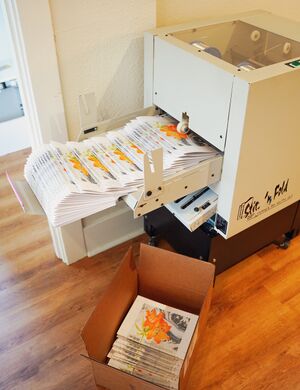Booklet Maker
Booklet Makers are machines that fold and bind a booklet or zine in one pass.

A collated, unfolded stack of interior pages + cover is inserted into the machine, and it folds and staples (using staples or wire from a spool) to make the booklet. This process is much faster and more accurate than folding the pages by hand.
Typical Capabilities of Booklet Makers
Booklet makers can go inline after a collating tower, binding up to 2,300 books/hour, depending on the model. More commonly for artists, they are fed by hand (500 books in 45 minutes or so, once experienced with use). A conveyor belt feeds the paper through the machine, and out the exit tray.
Booklet makers often can handle 2 to 25 sheets of 20# bond (100 page book), but it depends on the model and brand.
Staples vs Wire Binding
Booklet makers which use staples need to be reloaded every length of staples (typically 120 staples), and they can experience staple jams which slow production. Booklet makers with wire feed get about 65,000 booklets per spool of wire. Booklet makers use two spools at a time and spools cost about $35-60/spool, so material costs are on the order of a tenth of a penny per booklet. Wire spools also come in a variety of colors, so you can have colored wire staples where the color doesn't flake off like painted staples.
Some booklet maker models also have the ability to fold only (no staples) or staple on the sides or corners instead of on the fold.
Booklet Maker Models
Examples of booklet maker brands/models used by risograph printers include:
- Stitch 'n Fold B2000
- Stitch 'n fold B1000
- Plockmatic 60
- Plockmatic 61
Considerations for buying a booklet maker
Typically artist publishers and stencil printers are in the used market for booklet makers, as new ones can range from several thousand to tens of thousands of dollars (USD). Anecdotally, booklet makers secondhand from the late 1990s-early 2000s have been found for $500-1000 in the US. Printshops that are closing; school printing departments, online auctions and online sites like Craigslist or Marketplace are common sources.
Here are a few things to consider for if/when buying a booklet maker could be a good idea:
- They are large and take up quite a bit of space: tabletop models take up several feet of space, or floor based models are similar to the size of a dishwasher, with tray tables that stick out. You also need to have room to stand on one side to feed booklets in and have a pile of your pre-collated book-blocks at hand, and space to remove them from the exit tray and pack them into boxes or other storage.
- They are heavy: some models are 200-250 lbs (~150kg) so for larger ones, having a rolling base and a stairs-free way to get them into a workspace can be important. Because they are heavy, even the ones on casters are not easily moved -- for example, you probably want a dedicated location/workspace for your booklet maker.
- Is it in working order? Do the rollers need to be replaced?
- Each time you change size or thickness of the booklets you are binding, there are a few minutes of adjustment to dial in the machine so it places the fold and staples in the correct place? Do you do large enough runs to make the setup time worthwhile?
- Can you share access to it with other publishers in your area?
